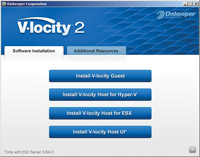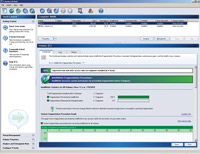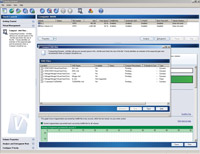Diskeeper V-locity 2: Server Virtualization Defrag
The defragmentation software for server virtualization offers useful features and unique value.
I first became familiar with Diskeeper Corp. in the mid-1990s. Windows NT had just started to become a mainstream operating system, but Microsoft didn't provide a solution for keeping Windows NT systems defragmented (as it had with Windows 9x). Diskeeper stepped up to the plate and offered a badly needed third-party defragmentation solution.
Eventually, Microsoft began including defragmentation capabilities in the OS. Given that Microsoft had chosen to develop its own defragmentation algorithms rather than acquiring Diskeeper, I assumed Diskeeper wouldn't be around for very much longer. That was well over a decade ago.
I have to admit, after Microsoft began enabling disk defragmentation natively within Windows, I didn't give Diskeeper a second look. This June, however, I was walking around the exhibit hall at Tech-Ed and stopped at the Diskeeper booth. I couldn't help but ask how Diskeeper had managed to survive. After all, why would anyone buy something that's included for free within the Windows OS?
The person I spoke with said that Diskeeper has a few different products on the market, but that its flagship product is V-locity 2 -- essentially defragmentation software that has been optimized for server virtualization. Intrigued, I decided to take a look.
Installation
Unlike many of the products I've been reviewing lately, the installation process for V-locity 2 was a breeze. The main installation screen provides options for deploying both host and guest components. Upon making your selection, setup guides you through a simple wizard that helps you to complete the installation process.

[Click on image for larger view.] |
| Figure 1. The main V-locity 2 setup screen. |
The only aspect of the setup process that I had some trouble with was the process of licensing my software, but I have to confess this was my own fault. Whenever I review a product, I initially try to install and use the product without first reading the documentation. I do this as a way of determining how intuitive the software is. Although the software's licensing process wasn't intuitive, the documentation clearly explained it.
The V-locity 2 Philosophy
How does Diskeeper sufficiently differentiate itself from the defragmentation mechanisms that are built into Windows? After spending some time with V-locity 2, I realized that Diskeeper has definitely found its niche. To understand why, it's necessary to put the nature of server virtualization into context.
Server virtualization is based on the premise that server hardware resources are almost always underutilized. Server virtualization products such as VMware ESX and Microsoft Hyper-V allow hardware resources to be used more thoroughly by allowing multiple virtual servers to make use of a single physical server.
Although server virtualization certainly has its benefits, it only works as long as the host server and each guest server have access to sufficient hardware resources. Thankfully, most of the server virtualization products on the market allow you to allocate specific memory, CPU and disk resources to each individual virtual machine (VM). This does not, however, entirely prevent resource contention from becoming an issue. There are some resources that simply can't be allocated -- at least not in the traditional manner.
| REDMOND RATING | Installation: 20% | 9.0 | Features: 20% | 10.0 | Ease of Use: 20% | 10.0 | Administration: 20% | 8.0 | Documentation: 20% | 9.0 | Overall Rating: | 9.2 |
Key: 1: Virtually inoperable or nonexistent 5: Average, performs adequately 10: Exceptional | | |
One such resource is disk input/output (I/O). Imagine, for instance, that you have one large storage array containing the virtual hard drives for each of five different virtual servers. Although disk space might not be an issue, disk I/O is. In other words, a virtual server can only perform read and write operations on the storage array when the array isn't busy. If a VM is performing a read or a write operation, all of the other VMs must wait for the operation to complete before they can access the array. When you also consider that disk-based storage is usually a server's slowest hardware component, it becomes obvious as to why it's critical that your virtual servers use disk resources as efficiently as possible.

[Click on image for larger view.] |
| Figure 2. This system has IntelliWrite enabled. |
One of the best ways to improve the efficiency of hard-disk access is to keep the disk defragmented. However, the defragmentation process can be a challenge in a virtualized environment. The defragmentation process itself tends to be very disk-intensive. Even though the system might run more efficiently once a defragmentation completes, the defragmentation process itself can slow the system to a crawl while it's running.
Diskeeper came up with an ingenious solution to this problem: It designed V-locity 2 in a way that prevents disk fragmentation from occurring in the first place. V-locity 2 uses a technology that Diskeeper calls IntelliWrite to prevent up to 85 percent of all fragmentation. It does this by ensuring that files are written to the disk in a contiguous manner whenever possible. Because files are written contiguously, I/O operations require fewer movements of the drive heads, resulting in improved performance.
A side effect worth mentioning is that when scheduled defragmentation operations do occur, they should complete much more quickly because the drives should contain very little fragmentation.
When the people at Diskeeper told me that V-locity 2 was designed to prevent fragmentation from occurring in the first place, I expressed concern about the amount of system overhead consumed by IntelliWrite. However, I learned that V-locity 2 uses a technology called InvisiTasking to help with this.
InvisiTasking is a proprietary Diskeeper technology that monitors the hypervisor to see what hardware resources are being used at a given moment. By doing so, it's able to coordinate the defragmentation process for the host server and for the individual VMs in a way that prevents them from disrupting more critical system processes. Essentially, InvisiTasking makes use of CPU and disk I/O resources that would have otherwise been unused.

[Click on image for larger view.] |
| Figure 3. V-locity 2 is able to compact .VHD files. |
.VHD Compression
The on-the-fly decompression alone makes V-locity 2 a great product, but there's another feature that will be of tremendous benefit to organizations running Microsoft Hyper-V.
Anytime you create a VM, Hyper-V will configure it to use a dynamically expanding virtual hard disk unless you specifically tell it to use a fixed-size virtual hard disk. Many IT professionals prefer to use dynamically expanding drives for two reasons.
First, dynamically expanding drives grow with your data. Second, dynamically expanding hard drives can be created instantly, whereas it can take hours to create a fixed-size virtual hard drive.
As great as dynamically expanding virtual hard drives are, however, there's one major disadvantage to using them: They grow as you add data to them, but the underlying .VHD files don't shrink when you remove data. V-locity contains a feature that can reclaim hard disk space by compacting .VHD files containing unused space. It identifies which drives are available for compacting and provides a recommendation of whether or not the drive should be compacted.
Although this feature seems to do a good job, .VHD files can only be compacted when they're not being used. Therefore, you'll have to shut down your VMs before compacting the underlying .VHD files.
Pricing and Availability
V-Locity is priced at $199.95 per CPU core, so a license for a quad-core server would cost $799.80. Most customers who decide to use V-locity will probably also want to invest in Diskeeper 2010 Administrator, a management console that allows for the centralized management of Diskeeper software. This optional component sells for $299.95.
All in all, I found V-locity to be a solid product. I was very impressed with its feature set. V-locity should be considered an essential for anyone operating virtual servers in a Hyper-V environment. Unfortunately, I was unable to test the ESX version, but I have no reason to suspect it would be any less impressive. For the price, however, I do wish Diskeeper had chosen to include a Diskeeper 2010 Administrator license.
Diskeeper V-locity 2
$199.95 per CPU core
Diskeeper Corp. | 800-829-6468 | Diskeeper.com